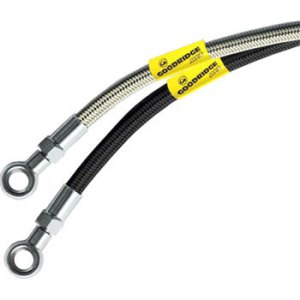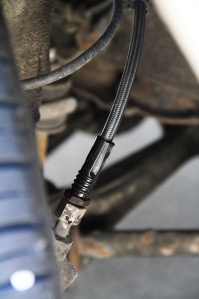It’s the old conundrum. After a simple brake job, a quick inspection of your brake flex-lines instills fear in your mind, giving you an unsettling thought that the next time you step on your brakes, a brake line could rupture and you’ll go careening off the road. However irrational the thought, when replacing brake lines, there is always the more rational question: stainless or rubber lines?
My OEM lines lasted 23 years
For my particular 1991 Volvo 940, I can find the following front brake lines:
Genuine Volvo rubber brake lines - $21.89
TechnaFit Stainless braided brake lines - $12.99
My OEM lines lasted 23 years before I decided to change them, which wasn't out of necessity but more for performance. We’ll get back to that. Based on price alone, there’s not a huge difference in brake lines. The quality of each hose is good enough for an everyday driver and will last you longer than you probably expect. So what’s the deal?
Stainless lines resist swell from hard braking
Stainless lines are chosen by enthusiasts because they look cool and for their link to racing. Stainless lines swell less than conventional rubber brake lines when the brake pedal is depressed. Racecar drivers trying to reduce their lap times by the hundredth of a second demand a direct feel from their brakes. They allow for a solid-feeling pedal, transferring the movement of the driver’s foot directly to the pads on the discs. Stainless lines will also resist swell from hard braking, lap after lap and the increased heat brake fluid sees in racing beyond what road cars usually see.
Does that mean rubber brake lines are inferior and you’ll be stepping on a sponge when you put them in? Not at all. What most enthusiasts fail to realize is, many rubber lines are also braided with steel as well, just on the inside where it isn’t visible. The rubber on the outside is merely a protective covering. Other rubber lines may utilize a nylon hose on the inside, which are more prone to swell under braking. Stainless lines are essentially constructed the same way, just without the exterior rubber but a heavier-duty stainless sheathing.
The stories you hear about stainless brake lines making your left pedal as hard as a rock are not untrue, it’s just that they probably didn’t tell the whole story. Chances are, the rubber lines they replaced were old and swelled more than average so their switch to stainless made them feel like the difference was purely down to stainless versus rubber. On my car, I decided to upgrade to stainless braided lines from Technafit. I’ll admit, I wanted to transform the brakes in my Volvo to be more racecar-like but sadly, there was only a slight improvement. In fact, if I wasn’t looking for the difference, I probably wouldn’t feel it.
At the end of the day, if you decide to upgrade from rubber to stainless, you are in fact buying a superior product. Technafit brake lines are quality parts. They’re D.O.T. certified with an inner PTFE core and permanently crimped on zinc-plated steel fittings. They are designed for abuse far greater than most drivers will ever submit their cars to and will give you greater confidence in the corners in case you ever decide to take your car to the track.












